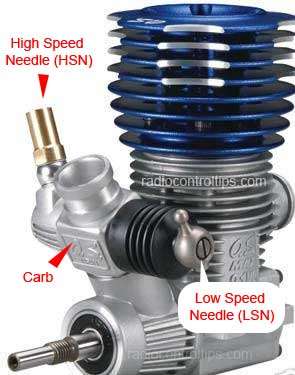Tuning a nitro engine for a radio-controlled (RC) car can seem intimidating at first, but with some patience and understanding, you can get it running smoothly. The goal is to adjust the fuel-air mixture settings using the carburetor’s needles to achieve optimal performance, reliability, and temperature. Below, I’ll walk you through the process step-by-step, focusing on the mixture settings—specifically the high-speed needle (HSN), low-speed needle (LSN), and idle screw.

Key Components to Understand
- High-Speed Needle (HSN): Controls the fuel-air mixture at full throttle. Too rich (too much fuel) causes sluggish performance and excess smoke; too lean (too little fuel) risks overheating and engine damage.
- Low-Speed Needle (LSN): Adjusts the mixture at idle and low throttle. This affects throttle response and idle stability.
- Idle Screw: Sets the idle speed by controlling how far the carburetor slide or barrel stays open at rest.
- Glow Plug: Ignites the fuel mixture. A healthy plug is crucial for tuning.
- Fuel: Typically a nitro methane blend (10-30% nitro content). Use the manufacturer-recommended mix.
Tools You’ll Need
- Small flathead screwdriver (for needle adjustments)
- Temperature gun (optional but highly recommended)
- Fresh fuel and a fueled-up tank
- A well-ventilated area or outdoor space
Step-by-Step Tuning Process
1. Start with Factory Settings
- Before tuning, reset the needles to the manufacturer’s baseline settings (check your engine manual). These are usually given in turns from fully closed (clockwise).
- Example: HSN might be 2.5 turns out, LSN 1.5 turns out. These vary by engine (e.g., Traxxas, OS, Novarossi).
- Ensure the engine is broken in (if new) per the manual—typically 3-5 tanks of gentle running.
2. Warm Up the Engine
- Start the engine and let it idle for 30-60 seconds to reach operating temperature. Use a glow plug igniter to get it going.
- If it won’t start, slightly richen (turn counterclockwise) the HSN or LSN by 1/8 turn and try again.
3. Set the Idle
- Adjust the idle screw so the engine idles steadily without stalling and the car doesn’t creep forward (unless clutched, where slight movement is normal).
- If the idle is too high, turn the idle screw counterclockwise. If it stalls, turn it clockwise.
4. Tune the Low-Speed Needle (LSN)
- Goal: Smooth transition from idle to mid-throttle with no hesitation.
- Pinch the fuel line near the carburetor for 1-2 seconds:
- If the engine revs up and then dies, the LSN is too lean—richen it (counterclockwise) by 1/8 turn.
- If it idles too long (>4-5 seconds) before dying, it’s too rich—lean it (clockwise) by 1/8 turn.
- Test throttle response: Blip the throttle. It should accelerate cleanly without bogging or stalling.
- Repeat until the pinch test results in the engine dying after 2-3 seconds, and throttle response feels crisp.
5. Tune the High-Speed Needle (HSN)
- Goal: Maximum power at full throttle without overheating.
- Run the car at full throttle on a straight stretch:
- Too rich: Excessive smoke, sluggish acceleration, wet exhaust residue. Lean it (clockwise) by 1/8 turn increments.
- Too lean: Little smoke, high-pitched scream, or engine cuts out. Richen it (counterclockwise) by 1/8 turn increments.
- Ideal: A thin, consistent smoke trail, strong acceleration, and temps between 200-250°F (93-121°C). Use a temp gauge on the cylinder head to confirm.
- After each adjustment, run a full-throttle pass and let it idle briefly to stabilize.
6. Final Checks
- Let the engine idle for 10-15 seconds, then pin the throttle. It should respond instantly without hesitation.
- Check the glow plug: A shiny coil means it’s healthy; a dull or damaged coil may need replacing.
- Monitor temperature: Over 270°F (132°C) indicates it’s too lean—richen the HSN immediately to avoid damage.
Tips for a Nice-Running Engine
- Listen to the Sound: A well-tuned nitro engine has a sharp, consistent tone—not too raspy (lean) or burbling (rich).
- Adjust for Conditions: Hot or humid days may require slight richening; cold days may need leaning.
- Run Slightly Rich: For longevity, err on the rich side (more smoke, cooler temps) rather than risking a lean condition.
- Clean the Air Filter: A clogged filter leans out the mixture—clean it with soapy water and re-oil it regularly.
- Use Fresh Fuel: Old or contaminated fuel can ruin tuning efforts.
Troubleshooting Common Issues
- Engine Stalls at Idle: LSN too lean or idle screw too low.
- Bogging Under Acceleration: LSN too rich or HSN too rich.
- Overheating: HSN too lean—stop immediately and richen it.
- Won’t Start: Check glow plug, fuel flow, or richen both needles slightly.
Tuning is an iterative process, so take your time and make small adjustments (1/8 turn at a time). Once you nail the settings, your nitro RC car should run powerfully and reliably.
